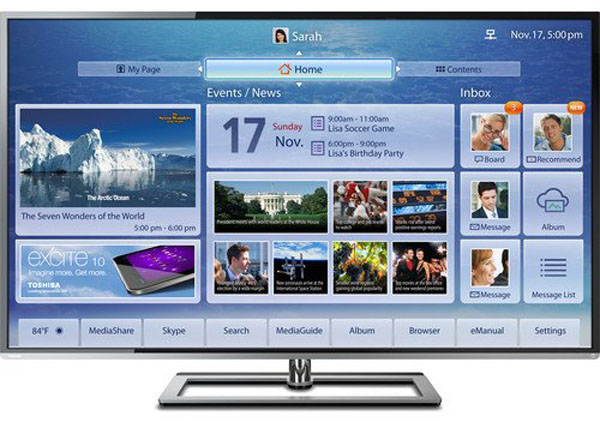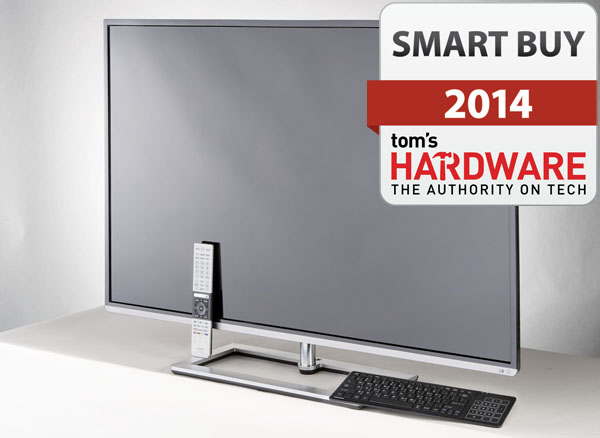Toshiba 50L7300U Review: A 50-Inch LED HDTV With Wi-Fi
You've seen us dramatically increase our display coverage over the last year, and now we're reviewing HDTVs too. Our first screen is Toshiba’s 50-inch L7300U Cloud TV with Wi-Fi. We run it through our lab and usability tests to see how it measures up.
Toshiba's 50-inch Cloud TV Delivers A Lot For The Money
For less than $900, Toshiba delivers tremendous value in the 50L7300U, and in all of its Cloud TVs for that matter. Even if you’re just in the market for a new HDTV and you don’t plan to use the networking-oriented features, this display is a top performer.
HDTVs should be held to the same standards as computer monitors, we think. They should accurately reproduce the Rec. 709 color gamut, achieve a D65 white point at all brightness levels, track a 2.2 gamma value, and deliver excellent contrast. Toshiba checks all of those boxes. While some of the picture modes show oversaturated color and a cool grayscale, the Movie mode is pretty good out of the box. Though we don’t expect many users will pay a professional calibrator to tune a set at this price level, the benefit is worth the expense. We attained a level of accuracy equal to any high-end flat panel or projector thanks to the full color management system and 10-point white balance adjustment.
While Toshiba's contrast is lower than the average plasma screen, it compares favorably with just about any LCD out there, at any price point. Since the 50L7300U (like most HDTVs) has separate backlight and black level adjustments, you can dial in maximum contrast and maintain that at any light level. This makes the display extremely versatile, since it can be easily adapted to any lighting conditions your room may have. We couldn’t create day and night presets, but it’s very easy to simply change the backlight control when you want more or less output. Please try the settings we published on page three. While they won’t give you the same results as an instrumented calibration, you’ll get pretty close.
Even though the quantitative tests tell us that the TV's image looks great, we watched plenty of real-world content to be sure. And we were not disappointed. Every movie we ran through the 50L7300U looked like reference-level material. The set delivered naturally saturated color, excellent contrast, and sharply focused detail. We tried out Toshiba’s dynamic contrast and local dimming options and found that even though they work pretty well, the TV is good enough to do without those features.
The one weakness we need to point out involves video processing. Failures on the 2:2 and 3:2 pulldown tests means your DVDs won’t look their best unless you let your disc player do the deinterlacing. Fortunately, even the least-expensive models do a decent job with standard-def material. And we didn’t see any major issues with streamed content. The quality of Internet video varies greatly and you’re more likely to see artifacts from compression and bandwidth limitations rather than from anything produced by this display.
For cord-cutters considering the 50L7300U, there is plenty to watch on this TV with nothing more than a network connection. Thanks to the built-in Wi-Fi, you don’t even have to run an Ethernet cable to your entertainment center. You will need to exercise patience, however. The built-in apps don't run particularly quickly on the set's integrated platform. We do applaud the inclusion of a Bluetooth keyboard though, which greatly improves the user experience. Alternatively, you could hook your own media-oriented system up to the 50L7300U and leverage online services to free you from the cable or satellite bill.
Because the Toshiba 50L7300U delivers excellent performance and a lot of functionality at an extremely attractive price, we’re giving it the Tom’s Hardware Smart Buy award for value.
Get Tom's Hardware's best news and in-depth reviews, straight to your inbox.
We hope you’ve found our first HDTV review thorough and informative. We plan on continuing this coverage to bring you more televisions, plus the latest OLED and 4K displays in the near future. If there are aspects of these products that you'd like to see us go into more depth on, please let us know in the comments section.
Current page: Toshiba's 50-inch Cloud TV Delivers A Lot For The Money
Prev Page Results: Video Processing
Christian Eberle is a Contributing Editor for Tom's Hardware US. He's a veteran reviewer of A/V equipment, specializing in monitors. Christian began his obsession with tech when he built his first PC in 1991, a 286 running DOS 3.0 at a blazing 12MHz. In 2006, he undertook training from the Imaging Science Foundation in video calibration and testing and thus started a passion for precise imaging that persists to this day. He is also a professional musician with a degree from the New England Conservatory as a classical bassoonist which he used to good effect as a performer with the West Point Army Band from 1987 to 2013. He enjoys watching movies and listening to high-end audio in his custom-built home theater and can be seen riding trails near his home on a race-ready ICE VTX recumbent trike. Christian enjoys the endless summer in Florida where he lives with his wife and Chihuahua and plays with orchestras around the state.

